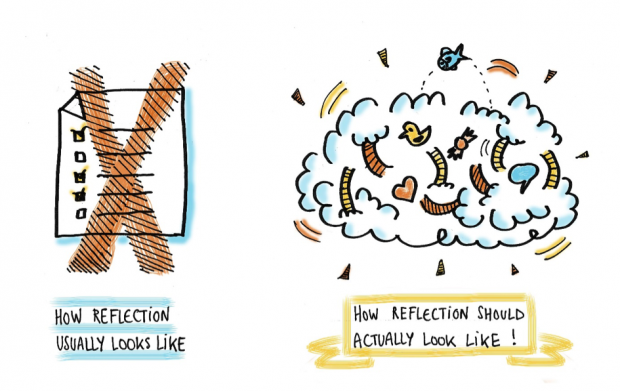Reflection assignments as an active learning strategy are commonly seen in humanities courses. The purpose of this writing is to share an example of how simple reflection activities can make a huge impact in two math courses.
MTH 251 Differential Calculus covers five units, with one exam for each unit, counting 14% of the final grade. Before students attempt to take the unit exam, they are assigned to read textbook readings, watch instructor-created lecture videos, work on Canvas-based homework assignment and Adaptive Learning based practice assignments in Knewton Lab online platform. After assignment due date expires, students are assigned to complete a weekly written homework reflection. The weekly homework and the weekly homework reflection together count for 14% of final grade in this course, weighing the same as each of the unit exams.
MTH 341 Linear Algebra I has ten weekly modules. Each week, students read textbook assigned readings, watch lecture videos created by the instructor (Dr. ), complete post-reading questions in quiz format, work on graded group discussion questions to solve math problems in small groups, complete written homework individually, and in the following week, complete a written homework response activity individually in discussion format.
The written homework reflection in MATH 251 and the written homework response in MATH 341 are both reflection activities designed to optimize student learning success, through comparing their own homework solutions with answer keys and evaluate whether they did it correctly or incorrectly and analyze where they did it wrong and how to get it right. The purpose of such weekly reflection is to help students develop meta-cognitive skills related to their learning. By looking back at students’ own work and learning from their mistakes, they develop an understanding of what is the proper way to solve a problem and what is not the proper way for solving a particular math problem. It also prompts students to plan for proper action in the future and exercises students’ executive functioning skills (CAST, 2018).
Here is what the instructions for the weekly reflection look like:
1. First answer the weekly prompt: Reflecting on the Unit 1 module, which topics did you struggle with the most?
2. Download the written homework solutions PDF: (Solution for each written homework in pdf format is attached here.)
3. Look over the solutions and compare to your submitted homework. Look for any problems where your solution differs from the posted solution.
-
- If your solutions had one or more incorrect problems then in the discussion board please discuss the following:
- why you struggled with certain problems
- why each solution makes sense now
- what your misunderstanding was
- what will you do in the future when solving problems similar to these?
- what strategies will help you?
- what did you learn by making a mistake?
- what did you learn from looking at the solutions?
- If you are still confused about a problem, ask a question. DO NOT simply list which problems you got wrong.
- If your solutions are all correct then in the discussion board please discuss the problem that you found the most challenging. Describe what specific tasks helped you to complete that problem. Be as detailed as you can about your solution process.
- If your solutions had one or more incorrect problems then in the discussion board please discuss the following:
Students not only posted their own reflections, but they also comment on or answer other students’ reflections as well. Additionally, the instructor and the four TAs in the course responded actively to students’ reflections, which makes the reflection more valuable since students get encouragement, praises, or corrections from the instructor and teaching assistants. Again, feedback from experts is critical in the success of a reflection activity (Vandenbussche, 2018)

Image 1: How reflection usually looks like and How reflection should look like (Image Source)
Many students were reflecting on what they did wrong and asked for help. Some were reflecting on their time management in completing the homework assignments. And we were glad to see students completing homework, evaluating their own work, analyzing where they did wrong, and planning for future improvement. Overall, the purpose of this assignment is accomplished!

(Image by Dave_Here)
A great benefit that comes from these weekly reflection activities is increased or sustained homework completion rate. For MTH 251 winter 2021 week 1 to week 7, over 85% of students completed the weekly homework and the reflection activity on average. For MTH 341 Fall 20 week 1 to week 7, over 90% of students on average completed the weekly homework and the reflection assignments. All math teachers love to see their students practice with homework assignments before they attempt to take the quizzes or exams! And evidence-based research tells us that deliberate practice with targeted feedback promotes mastery learning (Ambrose et al., 2010).
So, if it works in math courses, it will work in Chemistry, Biology, Physics, Engineering and other STEM courses too! If you’re interested in implementing this technique in your teaching and have questions about setting it up, feel free to contact us. We’d love to help you figure out the easiest way to set it up in your course.
References
Ambrose, S.A., Bridges, M.W., DiPietro, M., Lovettt, M.C. , Norman, M.K., & The Eberly Center for Teaching Excellence at Carnegie Mellon University. (2010). How learning works: Seven research-based principles for smart teaching. San Francisco, CA: Jossey-Bass
CAST. (2018). UDL Guidelines. Retrieved from https://udlguidelines.cast.org/
Vandenbussche, B. (2018). Reflecting for learning. Retrieved from https://educationaltoolsportal.eu/en/tools-for-learning/reflecting-learning

 (image from pxfuel.com)
(image from pxfuel.com) In 2019, I worked with an instructor developing a biochemistry/biophysics course for Ecampus. The instructor loved the peer-to-peer interaction intended for discussions, but was discouraged by the often lackluster exchange commonly demonstrated in the posts. She wanted to liven up these conversations, not only to increase the strength of the community but also to have an impact on the value of the learning that took place.
In 2019, I worked with an instructor developing a biochemistry/biophysics course for Ecampus. The instructor loved the peer-to-peer interaction intended for discussions, but was discouraged by the often lackluster exchange commonly demonstrated in the posts. She wanted to liven up these conversations, not only to increase the strength of the community but also to have an impact on the value of the learning that took place. From this list of 5 to 10 conversation starters that give breadth to the topics, the students can choose which they want to respond to, often selecting what’s of greatest interest to them. These posts could be anything related to the topic or question, so students are free to approach from any perspective or direction.
From this list of 5 to 10 conversation starters that give breadth to the topics, the students can choose which they want to respond to, often selecting what’s of greatest interest to them. These posts could be anything related to the topic or question, so students are free to approach from any perspective or direction. In the new version, students first answer and submit solutions to the homework individually, and this initial phase is graded on proper application of concepts, rather than on the correctness of the answer. Next, students work together in small groups of 3 or 4 to discuss the same set of problems and, as a group, arrive at consensus of the correct answers.
In the new version, students first answer and submit solutions to the homework individually, and this initial phase is graded on proper application of concepts, rather than on the correctness of the answer. Next, students work together in small groups of 3 or 4 to discuss the same set of problems and, as a group, arrive at consensus of the correct answers. These are just two simple but ingenious ways to reformat classic forms of interaction and assessment.
These are just two simple but ingenious ways to reformat classic forms of interaction and assessment. Why Use Active Learning?
Why Use Active Learning?
 In 2004, a skeptical Michael Prince (2004) researched the then-current literature on active learning to determine whether it offered consideration for engineering. He found that many active learning recommendations directly conflicted with historical engineering teaching practices. Methods like breaking lectures into small, topic-specific segments, interspersing lecture with discussion, using problem-based scenarios, or grouping students for collaborative learning were uncommon. Ultimately, Prince reluctantly concluded that the bulk of research evidence indicated that these types of teaching methods might foster better retention and enhance critical thinking.
In 2004, a skeptical Michael Prince (2004) researched the then-current literature on active learning to determine whether it offered consideration for engineering. He found that many active learning recommendations directly conflicted with historical engineering teaching practices. Methods like breaking lectures into small, topic-specific segments, interspersing lecture with discussion, using problem-based scenarios, or grouping students for collaborative learning were uncommon. Ultimately, Prince reluctantly concluded that the bulk of research evidence indicated that these types of teaching methods might foster better retention and enhance critical thinking.
 Design activities that encourage students to work in small groups or collaborate with others.
Design activities that encourage students to work in small groups or collaborate with others.